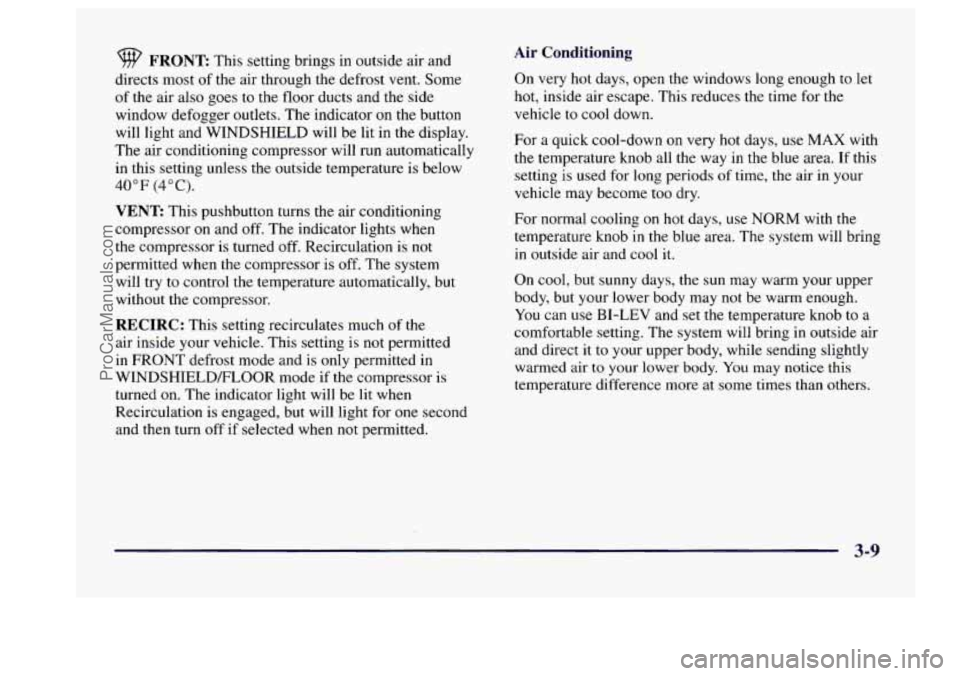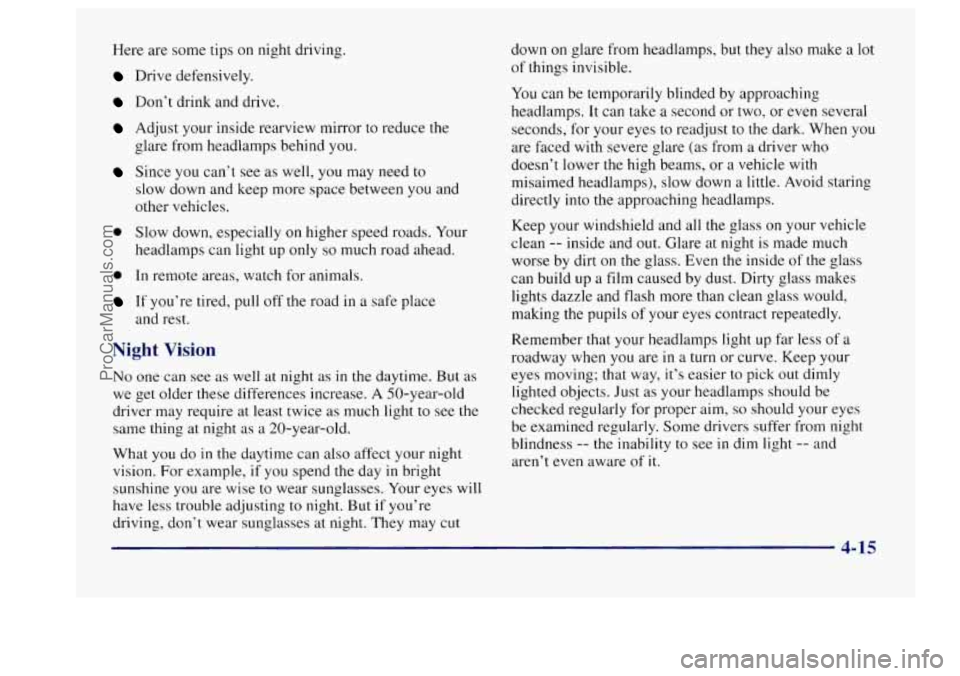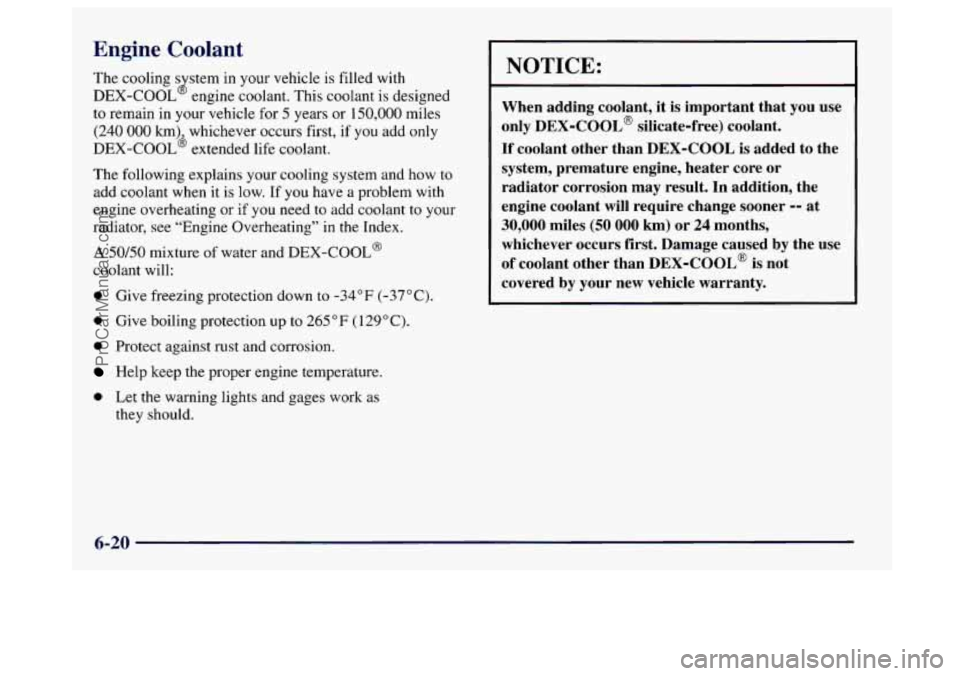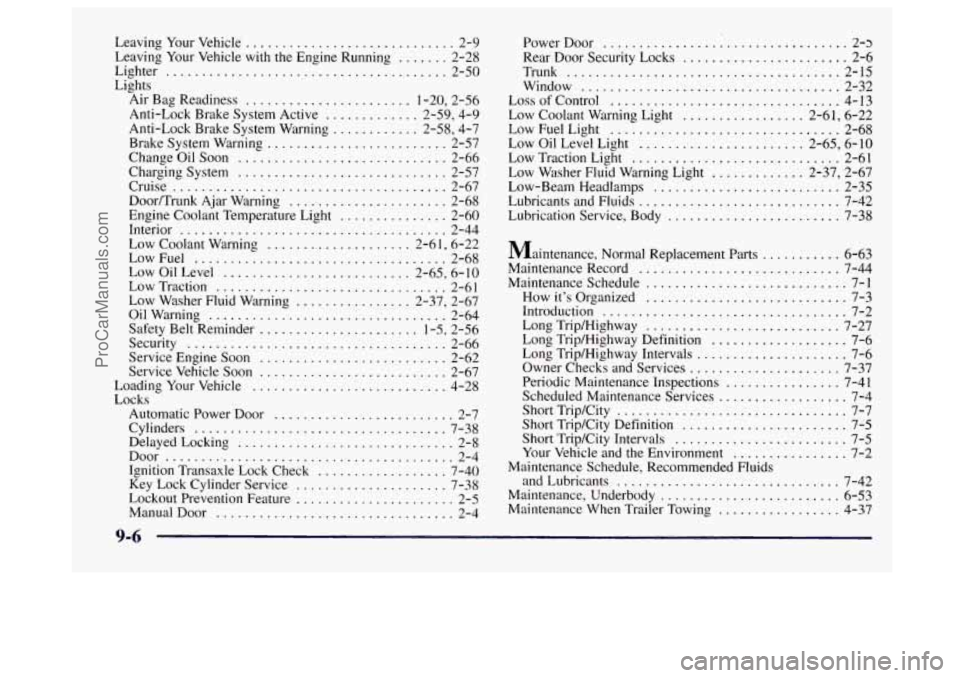1997 BUICK CENTURY lights
[x] Cancel search: lightsPage 153 of 406

FRONT This setting brings in outside air and
directs most of
the air through the defrost vent. Some
of the air also goes
to the floor ducts and the side
window defogger outlets. The indicator on the button
will light and WINDSHIELD will be lit in the display.
The air conditioning compressor will run automatically
in this setting unless the outside temperature is below
40°F (4°C).
VENT This pushbutton turns the air conditioning
compressor
on and off. The indicator lights when
the compressor is turned
off. Recirculation is not
permitted when
the compressor is off. The system
will try
to control the temperature automatically, but
without the compressor.
RECIRC: This setting recirculates much of the
air inside your vehicle. This setting is not permitted
in FRONT defrost mode and is only permitted in
WINDSHIELD/FLOOR mode if the compressor is
turned on. The indicator light will be
lit when
Recirculation is engaged, but will light for
one second
and then turn off if selected when not permitted.
Air Conditioning
On very hot days, open the windows long enough to let
hot, inside air escape. This reduces the time for the
vehicle to cool down.
For a quick cool-down on very hot days, use MAX with
the temperature knob all the way in the blue area. If this
setting
is used for long periods of time, the air in your
vehicle may become too dry.
For normal cooling on hot days, use NORM with the
temperature knob
in the blue area. The system will bring
in outside air and cool it.
On cool, but sunny days, the sun may warm your upper
body, but your lower body may
not be warm enough.
You can use BI-LEV and set the temperature knob to a
comfortable setting. The system will bring
in outside air
and direct it to your upper body, while sending slightly
warmed air
to your lower body. You may notice this
temperature difference more
at some times than others.
3-9
ProCarManuals.com
Page 201 of 406

Here are some tips on night driving.
Drive defensively.
Don’t drink and drive.
Adjust your inside rearview mirror to reduce the
glare from headlamps behind
you.
Since you can’t see as well, you may need to
slow down and keep more space between you and
other vehicles. down on
glare from headlamps, but they
also make a lot
of things invisible.
You can be temporarily blinded by approaching
headlamps.
It can take a second or two, or even several
seconds,
for your eyes to readjust to the dark. When you
are faced with severe glare
(as from a driver who
doesn’t lower the high beams, or a vehicle with
misaimed headlamps), slow down a little. Avoid staring
directly into the approaching headlamps.
0 Slow down, especially on higher speea roads. Your
headlamps can light
up only so much road ahead.
0 In remote areas, watch for animals.
If you’re tired, pull off the road in a safe place
and rest.
Night Vision
No one can see as well at night as in the daytime. But as
we get older these differences increase.
A 50-year-old
driver may require at least twice
as much light to see the
same thing at night as a 20-year-old.
What you do
in the daytime can also affect your night
vision. For example,
if you spend the day in bright
sunshine you are wise to wear sunglasses. Your eyes will
have less trouble adjusting to night. But if you’re
driving, don’t wear sunglasses at night. They may cut Keep your windshield and all the glass
on your vehicle
clean
-- inside and out. Glare at night is made much
worse by dirt
on the glass. Even the inside of the glass
can build up
a film caused by dust. Dirty glass makes
lights dazzle and flash more than clean glass would,
making the pupils of your eyes contract repeatedly.
Remember that your headlamps light up far less of
a
roadway when you are in a turn or curve. Keep your
eyes moving; that way, it’s easier
to pick out dimly
lighted objects. Just as your headlamps should be
checked regularly for proper aim,
so should your eyes
be examined regularly. Some drivers suffer from night
blindness
-- the inability to see in dim light -- and
aren’t even aware
of it.
4- 15
ProCarManuals.com
Page 286 of 406

Engine Coolant
The cooling s stem in your vehicle is filled with
DEX-COOL engine coolant. This coolant is designed
to remain in your vehicle for
5 years or 150,000 miles
(240 000 km) whichever occurs first, if you add only
DEX-COOL’ extended life coolant.
J
The following explains your cooling system and how to
add coolant when it is low.
If you have a problem with
engine overheating or if you need to add coolant to your
radiator, see “Engine Overheating”
in the Index.
A 50/50 mixture of water and DEX-COOL@
coolant will:
0 Give freezing protection down to -34°F (-37°C).
0 Give boiling protection up to 265 OF ( 129 O C).
0 Protect against rust and corrosion.
Help keep the proper engine temperature.
0 Let the warning lights and gages work as
they should.
NOTICE:
When adding coolant, it is important that you use
only
DEX-COOL@ silicate-free) coolant.
If coolant other than DEX-COOL is added to the
system, premature engine, heater core or radiator corrosion may result. In addition, the
engine coolant will require change sooner
-- at
30,000 miles (50 000 km) or 24 months,
whichever occurs first. Damage caused by the use
of coolant other than DEX-COOL@ is not
covered
by your new vehicle warranty.
6-20
ProCarManuals.com
Page 398 of 406

Leaving Your Vehicle ............................. 2-9
Leaving Your Vehicle with the Engine Running
....... 2-28
Lighter
....................................... 2-50
Lights Air Bag Readiness
....................... 1-20’2-56
Anti-Lock Brake System Active
............. 2-59, 4-9
Anti-Lock Brake System Warning
............ 2-58, 4-7
Brake System Warning
......................... 2-57
Change Oil Soon
............................. 2-66
Charging System
............................. 2-57
Door/Trunk Ajar Warning
...................... 2-68
Engine Coolant Temperature Light
............... 2-60
Interior
..................................... 2-44
Low Coolant Warning
.................... 2-61, 6-22
LowFuel
................................... 2-68
Low Oil Level
.......................... 2-65, 6- 10
Low Traction ................................ 2-6 1
Low Washer Fluid Warning ................ 2-37, 2-67
Oilwarning
................................. 2-64
Safety Belt Reminder
...................... 1-5, 2-56
Security
.................................... 2-66
Service Engine Soon
.......................... 2-62
Service Vehicle Soon
.......................... 2-67
Loading Your Vehicle
........................... 4-28
Cylinders
................................... 7-38
Delayed Locking
.............................. 2-8
Cruise
...................................... 2-67
Locks Automatic Power Door
......................... 2-7
Door
........................................ 2-4
Ignition Transaxle Lock Check
.................. 7-40
Key Lock Cylinder Service
..................... 7-38
Lockout Prevention Feature
...................... 2-5
ManualDoor
................................. 2-4 PowerDoor
.................................. 2-3
Rear Door Security Locks ....................... 2-6
Trunk
...................................... 2-15
Window
..................................... 2-32
Loss of Control
................................ 4-13
Low Coolant Warning Light
................. 2-61, 6-22
Low Oil Level Light
....................... 2-65, 6-10
Low Traction Light ............................. 2-61
Low Washer Fluid Warning Light ............. 2-37, 2-67
Low-Beam Headlamps
.......................... 2-35
Lubricants
and Fluids ............................ 7-42
Lubrication Service, Body
........................ 7-38
LowFuelLight
................................ 2-68
Maintenance, Normal Replacement Parts
........... 6-63
Maintenance Record ............................ 7-44
How it’s Organized
............................ 7-3
Long Trip/Highway
........................... 7-27
Long Trip/Highway Definition
................... 7-6
Long Tripmighway Intervals ..................... 7-6
Owner Checks and Services
..................... 7-37
Periodic Maintenance Inspections
................ 7-41
Scheduled Maintenance Services
.................. 7-4
Short Trip/City
................................ 7-7
Short Trip/City Definition
....................... 7-5
Short Trip/City Intervals
........................ 7-5
Your Vehicle and the Environment
................ 7-2
and Lubricants ............................... 7-42
Maintenance, Underbody
......................... 6-53
Maintenance When Trailer Towing
................. 4-37
Maintenance Schedule
............................ 7-1
Introduction
.................................. 7-2
Maintenance Schedule, Recommended Fluids
9-6
ProCarManuals.com
Page 403 of 406

TTYUsers ..................................... 8-4
Turn Signal and Lane Change Indicator
............. 2-34
Turn Signal On Chime
........................... 2-35
Turn Signal/Multifunction Lever
................... 2-34
Turn Signals When Towing a Trailer
................ 4-36
Twilight Sentinel
............................... 2-43
Two-way Manual Seat
........................... 1-2
Underbody Flushing Service
..................... 7-40
Underbody Maintenance
......................... 6-53
Underhood Electrical Center (Passenger’s Side)
....... 6-60
Vehicle Control
...................................... 4-6
Damage Warnings
.............................. ix
Dimensions ................................. 6-63
Identification Number
......................... 6-55
Loading
.................................... 4-28
Storage
..................................... 6-30
Symbols
....................................... x
Ventilation System .............................. 3- 10
Visor Vanity Mirrors ............................ 2-5 1
Visors. Sun .................................... 2-50 warning
Devices
............................... 5-2
Warranty Information
............................. 8-8
Washing Your Vehicle ........................... 6-50
Weatherstrips
.................................. 6-50
Wheel Alignment
.................................. 6-43
Nut Torque ............................. 5-34. 6-62
Replacement
................................. 6-43
Used Replacement
............................ 6-44
Window Lock
.................................. 2-32
Windows
..................................... 2-32
Auto-Down
................................. 2-32
Power
...................................... 2-32
Windshield Washer
............................. 2-36
Fluid
.................................. 2-37. 6-25
Fluid Level Check
............................ 7-37
Windshield Wipers
.............................. 2-36
Blade Replacement
........................... 6-36
Fuses
...................................... 6-56
Winter Driving
................................. 4-24
Wiper Blade Check
............................. 7-38
Wiring. Headlamp
.............................. 6-56
WreckerTowing
................................. 5-9
Warning Lights. Gages and Indicators ............... 2-55
Your Driving and the Road
....................... 4-1
9-11
ProCarManuals.com